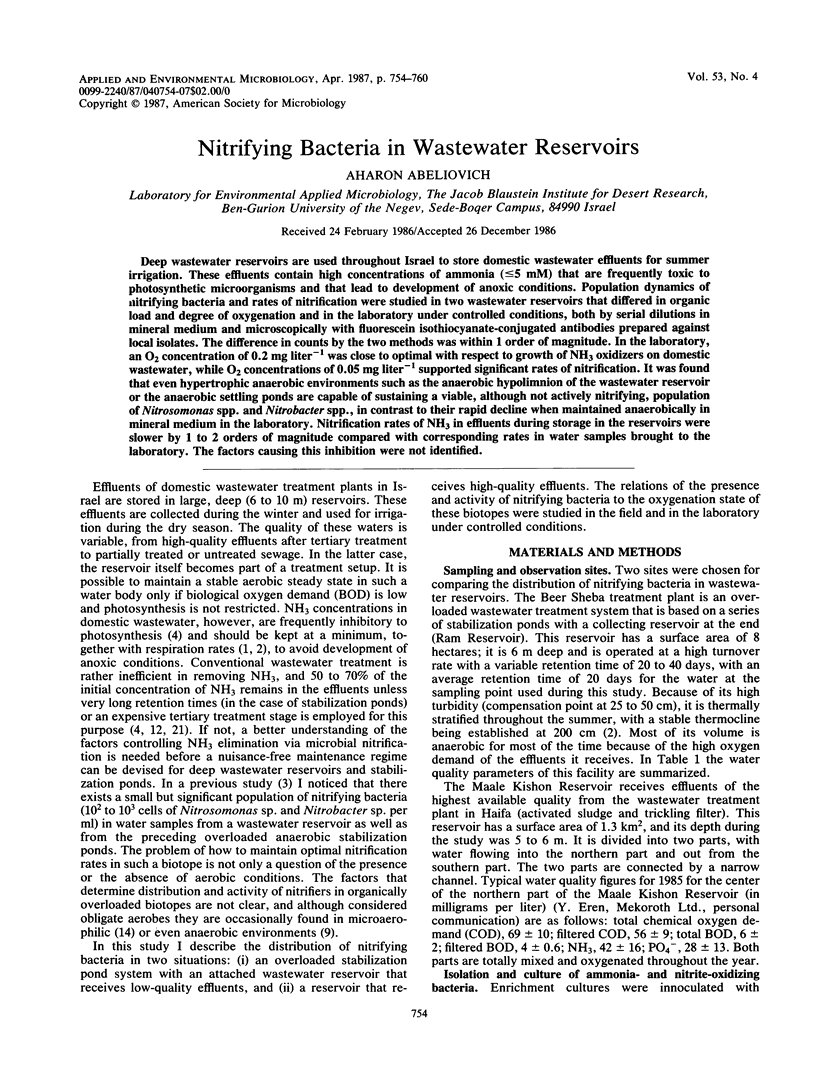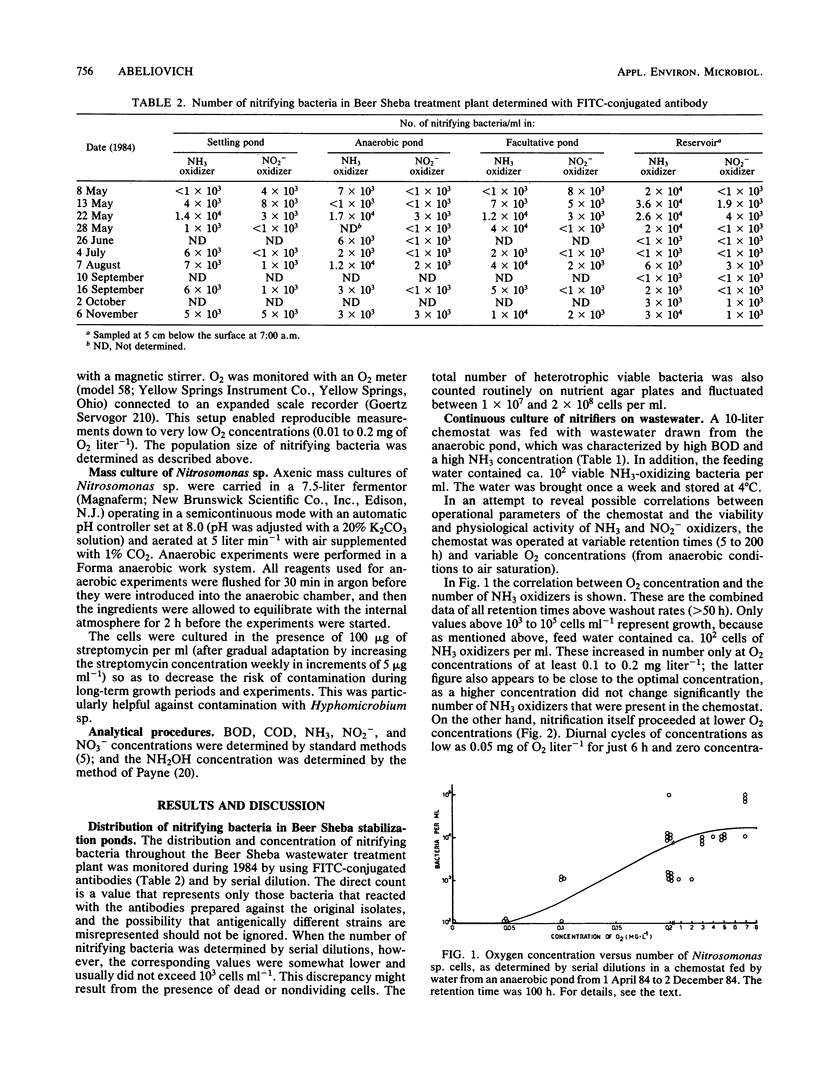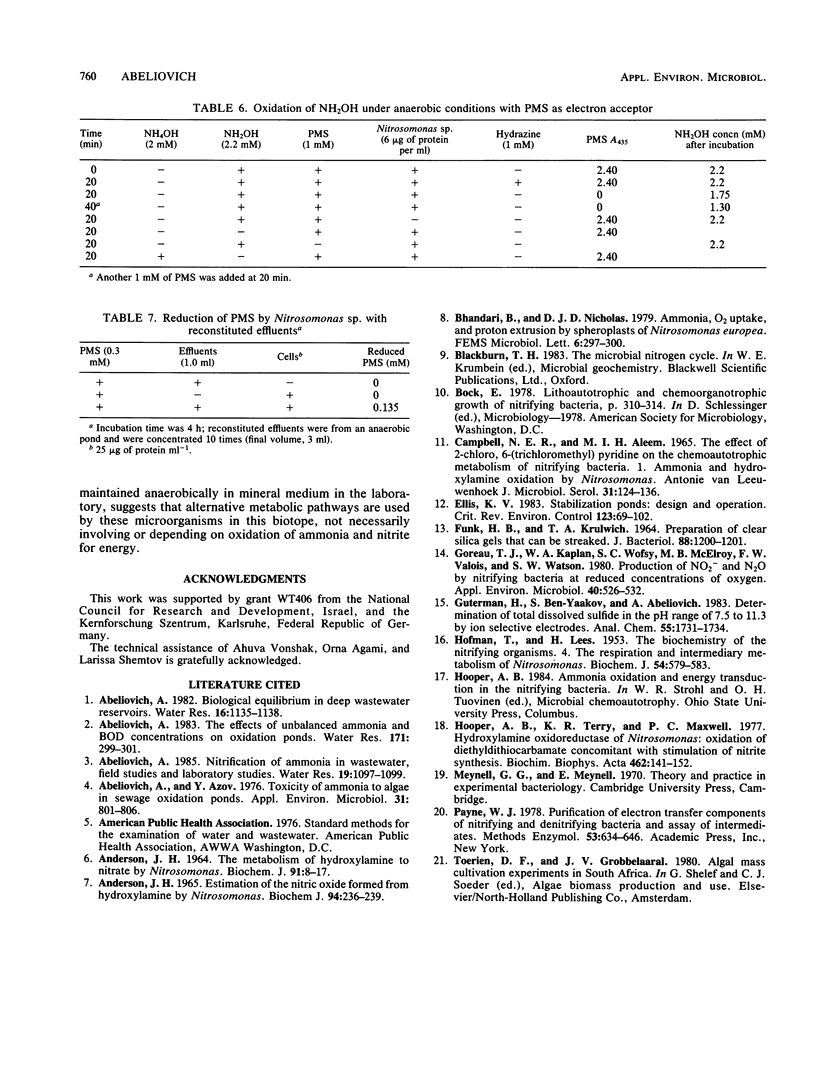Abstract
Deep wastewater reservoirs are used throughout Israel to store domestic wastewater effluents for summer irrigation. These effluents contain high concentrations of ammonia (≤5 mM) that are frequently toxic to photosynthetic microorganisms and that lead to development of anoxic conditions. Population dynamics of nitrifying bacteria and rates of nitrification were studied in two wastewater reservoirs that differed in organic load and degree of oxygenation and in the laboratory under controlled conditions, both by serial dilutions in mineral medium and microscopically with fluorescein isothiocyanate-conjugated antibodies prepared against local isolates. The difference in counts by the two methods was within 1 order of magnitude. In the laboratory, an O2 concentration of 0.2 mg liter−1 was close to optimal with respect to growth of NH3 oxidizers on domestic wastewater, while O2 concentrations of 0.05 mg liter−1 supported significant rates of nitrification. It was found that even hypertrophic anaerobic environments such as the anaerobic hypolimnion of the wastewater reservoir or the anaerobic settling ponds are capable of sustaining a viable, although not actively nitrifying, population of Nitrosomonas spp. and Nitrobacter spp., in contrast to their rapid decline when maintained anaerobically in mineral medium in the laboratory. Nitrification rates of NH3 in effluents during storage in the reservoirs were slower by 1 to 2 orders of magnitude compared with corresponding rates in water samples brought to the laboratory. The factors causing this inhibition were not identified.
Full text
PDF






Selected References
These references are in PubMed. This may not be the complete list of references from this article.
- ANDERSON J. H. ESTIMATION OF THE NITRIC OXIDE FORMED FROM HYDROXYLAMINE BY NITROSOMONAS. Biochem J. 1965 Jan;94:236–239. doi: 10.1042/bj0940236. [DOI] [PMC free article] [PubMed] [Google Scholar]
- Abeliovich A., Azov Y. Toxicity of ammonia to algae in sewage oxidation ponds. Appl Environ Microbiol. 1976 Jun;31(6):801–806. doi: 10.1128/aem.31.6.801-806.1976. [DOI] [PMC free article] [PubMed] [Google Scholar]
- Anderson J. H. The metabolism of hydroxylamine to nitrite by Nitrosomonas. Biochem J. 1964 Apr;91(1):8–17. doi: 10.1042/bj0910008. [DOI] [PMC free article] [PubMed] [Google Scholar]
- CAMPBELL N. E., ALEEM M. I. THE EFFECT OF 2-CHLORO, 6-(TRICHLOROMETHYL) PYRIDINE ON THE CHEMOAUTOTROPHIC METABOLISM OF NITRIFYING BACTERIA. I. AMMONIA AND HYDROXYLAMINE OXIDATION BY NITROSOMONAS. Antonie Van Leeuwenhoek. 1965;31:124–136. doi: 10.1007/BF02045882. [DOI] [PubMed] [Google Scholar]
- FUNK H. B., KRULWICH T. A. PREPARATION OF CLEAR SILICA GELS THAT CAN BE STREAKED. J Bacteriol. 1964 Oct;88:1200–1201. doi: 10.1128/jb.88.4.1200-1201.1964. [DOI] [PMC free article] [PubMed] [Google Scholar]
- Goreau T. J., Kaplan W. A., Wofsy S. C., McElroy M. B., Valois F. W., Watson S. W. Production of NO(2) and N(2)O by Nitrifying Bacteria at Reduced Concentrations of Oxygen. Appl Environ Microbiol. 1980 Sep;40(3):526–532. doi: 10.1128/aem.40.3.526-532.1980. [DOI] [PMC free article] [PubMed] [Google Scholar]
- HOFMAN T., LEES H. The biochemistry of the nitrifying organisms. IV. The respiration and intermediary metabolism of Nitrosomonas. Biochem J. 1953 Jul;54(4):579–583. doi: 10.1042/bj0540579. [DOI] [PMC free article] [PubMed] [Google Scholar]
- Hooper A. B., Terry K. R., Maxwell P. C. Hydroxylamine oxidoreductase of Nitrosomonas. Oxidation of diethyldithiocarbamate concomitant with stimulation of nitrite synthesis. Biochim Biophys Acta. 1977 Oct 12;462(1):141–152. doi: 10.1016/0005-2728(77)90196-7. [DOI] [PubMed] [Google Scholar]
- Payne W. J. Purification of electron-transfer components of nitrifying and denitrifying bacteria and assay of intermediates. Methods Enzymol. 1978;53:634–646. doi: 10.1016/s0076-6879(78)53063-2. [DOI] [PubMed] [Google Scholar]


